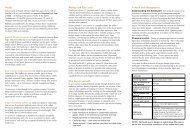Bushland Weeds Manual - Environmental Weeds Action Network
Bushland Weeds Manual - Environmental Weeds Action Network
Bushland Weeds Manual - Environmental Weeds Action Network
Create successful ePaper yourself
Turn your PDF publications into a flip-book with our unique Google optimized e-Paper software.
Chapter 5 Broadleaf Herbs, Sedges and Succulents<br />
Case Studies<br />
• Further spot fires in the<br />
following years have produced<br />
a germination of Holly-leafed<br />
Senecio. These have been dealt<br />
with as quickly as time and<br />
labour allow. Green Corps<br />
teams have been used but are<br />
not usually available at the time<br />
they are most needed.<br />
• Outcome: Areas where there<br />
is a good cover of natural<br />
vegetation have had very little<br />
Holly-leafed Senecio growing in<br />
the following years. However,<br />
along slashed firebreaks and<br />
under power lines, germination<br />
occurs every year. Outbreaks<br />
should be sprayed or hand -<br />
pulled in the first year following<br />
fire, to stop the spread of seed.<br />
• Being wind dispersed, there is<br />
probably seed all over the<br />
reserves, and any fire will result<br />
in further outbreaks.<br />
Case study 5.3<br />
As well as 260 hectares of the<br />
nature reserves to deal with,<br />
outlying populations also needed to<br />
be covered as a priority and<br />
resources were limited.<br />
In 2000, Holly-leafed Senecio was<br />
placed on the ‘Alert List for<br />
<strong>Environmental</strong> <strong>Weeds</strong>’ – weeds<br />
identified by Environment Australia<br />
as likely to be a significant threat to<br />
biodiversity. Grants to undertake onground<br />
actions to manage/control<br />
isolated populations of weeds listed<br />
became available. The objective was<br />
to prevent further establishment<br />
and expansion of listed weeds.<br />
The Department of Agriculture,<br />
Western Australia, City of Albany<br />
and Albany Bushcarers jointly<br />
applied for funding to have the<br />
current distribution of the Hollyleafed<br />
Senecio mapped and to<br />
implement a carefully targeted<br />
control program. They were<br />
successful and work will begin in<br />
spring 2002.<br />
The case study is an example of<br />
community, federal, state and local<br />
government working together to<br />
acquire resources and to<br />
implement effective on-ground<br />
management of weeds invading<br />
natural areas. With any one of the<br />
parties not present, the work<br />
would not be possible. It also<br />
highlights, again, the importance of<br />
early intervention and eradication<br />
of small infestations of new weeds.<br />
Source: Information for the case<br />
study was provided by Karin Baker,<br />
(Friend of Mt Adelaide & Mt<br />
Clarence Reserves), Greg Keighery<br />
(DCLM), John Moore (Western<br />
Australian Department of<br />
Agriculture, Albany) and Ryan<br />
Munro (City of Albany).<br />
Geraldton Carnation Weed (Euphorbia terracina) – managing the spread of a serious invader<br />
Geraldton Carnation Weed has<br />
been slowly spreading south and<br />
east over the last 60 years and<br />
habitats at risk include bushlands<br />
of the offshore islands and<br />
calcareous (limestone) plant<br />
communities throughout southern<br />
Western Australia (Keighery and<br />
Keighery 2000).<br />
Reproductive biology,<br />
dispersal and spread<br />
• Short-lived perennial herb to<br />
one metre.<br />
• Loses leaves and dies back to a<br />
stem in summer, reshooting<br />
with the first autumn rains.<br />
• Often but not always killed by<br />
fire.<br />
• Regenerates from soil-stored<br />
seed. Seed remains viable in<br />
the soil for at least 3-5 years.<br />
Bulk of seed germinates with<br />
onset of autumn rains but will<br />
germinate after good summer<br />
rains.<br />
• Seed released explosively<br />
from fruits.<br />
• Water, soil movement, birds<br />
(particularly feral doves), and<br />
possibly ants play a role in<br />
dispersal. Often introduced<br />
into bushland with crushed<br />
limestone material brought in<br />
for paths.<br />
• Is increasing on roadsides and<br />
highways. Soil movement and<br />
road maintenance machinery<br />
are one of the major<br />
mechanisms for long distance<br />
dispersal.<br />
(Source: Keighery and Keighery<br />
2000, Randall and Brooks 2000,<br />
Parsons and Cuthbertson 2001).<br />
Impacts<br />
In Western Australia Geraldton<br />
Carnation Weed can be found<br />
invading natural ecosystems from<br />
Geraldton to Cape Arid. It has been<br />
recorded in coastal dune heath,<br />
limestone heath, Tuart woodland,<br />
Banksia woodland and ephemeral<br />
wetlands. Once established it is<br />
able to invade relatively<br />
undisturbed bushland. It is a<br />
particularly serious weed of Tuart<br />
woodlands and one of the few<br />
serious weeds of coastal heath in<br />
south west Western Australia<br />
(Keighery and Keighery 2000).<br />
Control and Management in<br />
Kings Park<br />
Geraldton Carnation Weed is<br />
invading Kings Park Banksia<br />
woodlands in four main locations.<br />
Management has effectively<br />
focused on preventing spread<br />
through the identification and<br />
eradication of new outbreaks.<br />
• Volunteers and contractors are<br />
able to accurately identify the<br />
weed and new outbreaks are<br />
mapped as soon as located.<br />
• Large infestations are initially<br />
spot sprayed with herbicide<br />
Brush-off ® (1 g/150 L) or<br />
Brush-off ® + glyphosate.<br />
Follow-up includes regular<br />
inspection of the site and<br />
hand-removal of remaining<br />
plants. This continues for at<br />
least five years.<br />
Note: The entire plant must be removed.<br />
Plants as young as three weeks will resprout<br />
from any root material left behind.<br />
63



